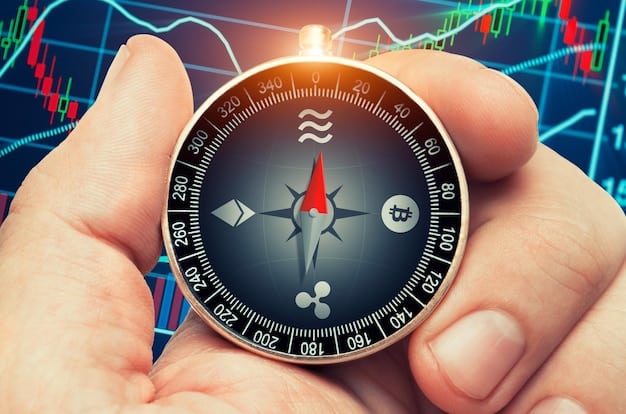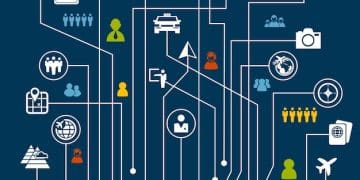Timeless Reports: Unmasking Economic Forecasting Misconceptions

Timeless Reports: The 3 Biggest Misconceptions About Economic Forecasting and How to Avoid Them reveals that economic forecasts are not crystal balls projecting the future, but rather tools susceptible to biases, oversimplification, and a failure to account for unforeseen events, which can be mitigated by understanding their limitations and incorporating diverse perspectives.
Economic forecasting is a complex field, often shrouded in mystery and perceived as an exact science. However, like any model, it’s subject to limitations and common misconceptions. Understanding these pitfalls is crucial for anyone making decisions based on economic predictions. Let’s unmask Timeless Reports: The 3 Biggest Misconceptions About Economic Forecasting and How to Avoid Them.
The Illusion of Certainty
One of the most prevalent misconceptions is treating economic forecasts as definitive pronouncements. Forecasts are, at their core, predictions based on current data and models, inherently susceptible to error and unforeseen events.
The Butterfly Effect in Economics
Even seemingly insignificant events can have a cascading effect on the economy, rendering forecasts inaccurate. This “butterfly effect” highlights the sensitivity of economic systems to initial conditions.
Consider the unexpected surge in oil prices due to geopolitical instability. Such an event can disrupt supply chains, increase inflation, and ultimately alter economic growth projections, showcasing the impossibility of predicting with certainty.

Model Limitations and Data Gaps
Economic models are simplifications of reality, designed to capture key relationships. However, they inevitably leave out certain factors, leading to potential inaccuracies. Data used in these models can also be incomplete or subject to revision.
- Model Oversimplification: Models can’t capture all the nuances of human behavior and market dynamics.
- Data Lags: Economic data is often released with a delay, making forecasts based on past information.
- Unforeseen Shocks: Unexpected events like pandemics or major policy changes can invalidate forecasts.
In conclusion, it’s vital to acknowledge the inherent uncertainty in economic forecasting, viewing predictions as probabilistic scenarios rather than guarantees.
Ignoring Behavioral Economics
Traditional economic models often assume rational behavior, yet human decisions are frequently influenced by emotions, cognitive biases, and social factors. Failing to account for these behavioral aspects can lead to flawed forecasts.
The Impact of Consumer Sentiment
Consumer confidence and sentiment play a significant role in driving economic activity. Forecasts that solely rely on quantitative data may overlook the impact of widespread optimism or pessimism on spending patterns.
For example, a sudden wave of fear due to a health crisis could cause consumers to curtail spending, regardless of interest rates or income levels, demonstrating the power of sentiment.
Herd Behavior and Market Bubbles
Behavioral economics explains how irrational exuberance and herd mentality can drive asset prices far beyond their fundamental values, creating market bubbles. Forecasts that neglect these dynamics may fail to anticipate impending corrections.
- Confirmation Bias: People tend to seek out information that confirms their existing beliefs, leading to biased forecasts.
- Loss Aversion: The pain of a loss is often felt more strongly than the pleasure of an equivalent gain, influencing investment decisions.
- Anchoring Bias: People rely too heavily on the first piece of information they receive (the “anchor”), even if irrelevant.
To improve forecasts, incorporate behavioral insights, considering psychological factors that drive economic decisions, ensuring a more nuanced understanding of market dynamics.
Over Reliance on Past Data
While historical data provides valuable insights, relying solely on past trends to predict the future can be misleading. Economic structures and relationships evolve over time, rendering past patterns less relevant.

Structural Changes in the economy
Technological advancements, demographic shifts, and globalization have fundamentally altered economic landscapes. Forecasts that fail to account for these structural changes risk producing inaccurate predictions.
For instance, the rise of e-commerce has disrupted traditional retail patterns, making forecasts based on pre-internet consumer behavior unreliable, thus signifying the importance of adaptability.
Black Swan Events
Unpredictable and high-impact events, often referred to as “black swan” events, can invalidate forecasts based on historical data. These events challenge the assumption of continuity that underlies many models.
- Ignoring Outliers: Overemphasis on average trends can obscure the potential impact of extreme events.
- Changing Regulations: New government policies can create significant shifts in economic behavior.
- Geopolitical Risks: International conflicts or trade wars can disrupt global supply chains.
A more robust approach involves integrating diverse data sources, considering scenario analysis, and adopting a flexible forecasting framework that adapts to evolving economic realities, ensuring forecasts remain relevant.
The Importance of Scenario Planning
Given the inherent uncertainty in economic forecasting, relying on a single “best-case” scenario is risky. Scenario planning involves developing multiple plausible scenarios and assessing their potential impact.
Stress Testing Economic Models
Stress tests simulate the impact of adverse events on the economy, helping identify vulnerabilities and assess the resilience of economic systems. These tests provide valuable insights for policymakers and businesses.
For example, simulating a severe recession can reveal the weaknesses in the financial system and highlight the need for stronger regulations, strengthening the forecasts reliability.
Developing Contingency Plans
Scenario planning enables the development of contingency plans, allowing organizations to respond effectively to different potential outcomes. This proactive approach enhances resilience and reduces the impact of unforeseen events.
- Identifying Key Drivers: Determine the factors that have the most significant impact on different scenarios.
- Quantifying Uncertainty: Assign probabilities to different scenarios based on available information.
- Monitoring Signals: Track indicators that provide early warning signs of a particular scenario unfolding.
By embracing scenario planning, decision-makers can prepare for a range of possibilities, mitigating risks and maximizing opportunities, leading to a more adaptable forecast.
Seeking Diverse Perspectives
Economic forecasting is often dominated by a narrow range of viewpoints. Incorporating diverse perspectives, including those from different disciplines, backgrounds, and geographical regions, can improve forecast accuracy.
Breaking Down Silos
Collaboration between economists, behavioral scientists, and other experts can lead to a more holistic understanding of economic dynamics. Cross-disciplinary insights can uncover hidden relationships and biases.
For instance, integrating sociological insights into economic models can provide a more nuanced understanding of consumer behavior, leading to more accurate predictions.
Challenging Conventional Wisdom
Encouraging dissent and debate challenges prevailing assumptions and exposes potential flaws in forecasting methodologies. A healthy skepticism promotes intellectual rigor and reduces the risk of groupthink.
- Seeking Alternative Models: Explore different economic models that incorporate diverse perspectives.
- Listening to Critics: Pay attention to dissenting voices and address their concerns.
- Avoiding Groupthink: Encourage independent thinking and open discussion.
By fostering a culture of intellectual diversity, organizations can tap into a wider range of knowledge, improving the robustness and accuracy of their economic forecasts, ensuring the long-term validity of the forecasts.
Communicating Forecasts Effectively
The manner in which economic forecasts are communicated can significantly impact their interpretation and use. Transparency, clarity, and appropriate caveats are essential for responsible forecasting.
Avoiding Technical Jargon
Complex economic concepts should be explained in plain language, avoiding unnecessary jargon that can confuse and alienate audiences. Clear communication ensures that users understand the assumptions, limitations, and uncertainties associated with forecasts.
For example, instead of referring to “quantitative easing,” explain its impact on interest rates and inflation in simple terms, making for an effective forecast.
Highlighting Uncertainty
Forecasts should explicitly acknowledge the range of potential outcomes, using probabilistic statements rather than point estimates. Communicating uncertainty helps manage expectations and encourages informed decision-making.
- Providing Confidence Intervals: Present forecasts as a range of values rather than a single number.
- Explaining Assumptions: Clearly state the assumptions underlying the forecasts.
- Acknowledging Limitations: Discuss the factors that could cause the forecasts to be inaccurate.
By prioritizing transparency and clarity, forecasters can ensure that their predictions are used responsibly, promoting informed decision-making and sound economic policy, helping to manage expectations of the forecasts.
| Key Point | Brief Description |
|---|---|
| 🔮 Illusion of Certainty | Forecasts are probabilistic, not definitive truths. Unforeseen events can drastically alter outcomes. |
| 🧠 Ignoring Behavior | Human emotions and biases influence economic decisions. Models must account for sentiment shifts. |
| 🕰️ Over Reliance on Past | Past data has its limitations. Economic structures evolve, rendering old patterns less reliable. |
| 🎭 Diverse perspectives | Collaboration between diverse experts and challenges prevailing assumptions. A healthy skepticism promotes intellectual rigor. |
Frequently Asked Questions
▼
Economic forecasts are inexact because they are based on models that simplify complex systems. Unforeseen events, like pandemics or geopolitical crises, can also significantly impact economic outcomes.
▼
The field incorporates psychological factors like consumer sentiment and herd behavior, acknowledging that people don’t always make rational decisions, thus affecting market dynamics and economic predictions.
▼
It involves creating multiple potential future scenarios to assess the range of possible outcomes, enabling more effective decision-making and better risk management in the face of uncertainty.
▼
Diverse perspectives challenge bias and promote innovation by considering different viewpoints. It enhances the robustness and accuracy of economic predictions for better decision-making.
▼
Clearly explain assumptions and limitations, while avoiding technical jargon. Using probabilistic forecasts and confidence intervals is crucial for effective communication, managing expectations, and well-informed decisions.
Conclusion
By recognizing the inherent limitations of economic forecasting and adopting strategies to mitigate biases, incorporating behavioral insights, and embracing diverse perspectives, decision-makers can leverage forecasts more effectively. Economic forecasting provides a valuable tool, when approached with prudence and understanding, for navigating the complexities of the economic future.





